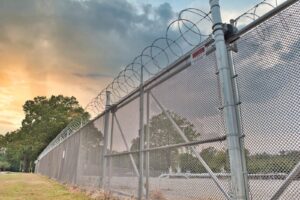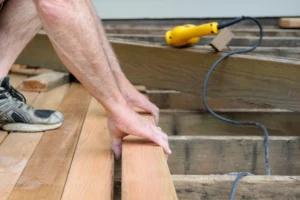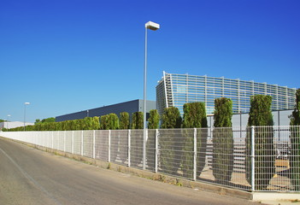Fence Installation Summerville SC offers some benefits to businesses. It can keep unauthorized people out and valuables in and prevent anyone from getting hurt on the property.
It can also help a business look good to everyone visiting or driving by the facility. A quality fence that is properly installed will last and retain its aesthetics for quite some time.

A commercial fence is a security measure that helps keep unwanted people and trespassers off your property. It can deter burglars and criminal activity by creating a barrier that unauthorized visitors cannot easily breach. In addition, this type of fencing can be used to protect outdoor equipment and machinery from theft. This is especially useful for companies that need to secure their inventory and tools stored outside their buildings.
Commercial fences are sturdier and generally have more structural integrity than residential fences. They are typically taller and have thicker aluminum gauges than their residential counterparts. They have eight metal support ribs and pickets that are closer together, making them more difficult to climb or cut through. These fences are geared towards their function and preventing trespassers over design or style.
This is because commercial property owners often have unique security and safety requirements. They have to deal with many visitors, including solicitors and potential customers. This can be a huge hassle and distract business owners from their core responsibilities. Having a commercial fence in place can limit the number of people allowed on their premises, making it easier for them to focus on their work without worrying about people entering their property.
In addition, this type of fence can also be a good choice for those living in neighborhoods with high crime rates. By installing a commercial fence, residents can create more of a deterrent and show that they take their security seriously. This is particularly important for families with children or pets, as a fence can help prevent them from wandering into unsafe areas or getting into pools unsupervised.
With the right installation team and materials, a commercial fence can provide an effective security solution for businesses of all kinds. From galvanized chain-link to ornamental wrought iron, these fences can be as sturdy and attractive as desired. Depending on a company’s specific needs, they can be fortified with height specifications, lighting, surveillance, omitted top rails, anchored bottom rails, double fencing rows, and elements such as concertina or barbed wire.
Many commercial properties have sensitive information that needs to stay private. A privacy fence is a good way to deter unauthorized access, protect business assets, and ensure that operations can occur without interruption. It also helps prevent crime by making it more difficult for thieves to break in.
Privacy fences are available in various aesthetic options to suit different businesses. For example, a wrought iron-style fence can add a sense of class to a commercial property. In contrast, an aluminum ornamental fence offers the look of wrought iron at a more affordable price point. Wood fences are also popular and can offer a more rustic look to commercial buildings like shopping centers and apartment complexes.
Another option for creating a privacy fence is to use shrubs and trees that will grow along your property line to create an all-natural fencing solution. Cypresses, red cedars, and shrubs like lilac can all be planted or extended to create a natural privacy fence that will block your property from neighbors’ views. In addition to being aesthetically pleasing, they also help prevent erosion and protect against wind.
If you’re looking for a more modern fence, composite fences offer the look of wood with the added benefit of being resistant to fading, stains, and chipping. They are durable and require little maintenance, making them a great option for commercial properties.
A good commercial fence installation company can provide expert advice on the best fencing solution for your business. They can also incorporate security features into your commercial fencing, which will deter criminals and may lower insurance premiums for your business.
A well-chosen and professionally installed fence can boost your commercial property’s appeal, adding value. Whether you’re looking to increase the value of your retail space or need to secure a warehouse full of expensive equipment, a quality commercial fence can do wonders. In today’s competitive real estate market, every aspect of your property should be scrutinized for its potential to add or detract from your business’s overall value.
Commercial fencing is designed to withstand heavy use and keep people or animals out. It usually has a thicker gauge of metal, and its pickets are closer together than residential fences. This allows it to hold up better against the elements, including snow, rain, and UV radiation. It also has additional features like aluminum finials, making it more visually appealing.
Many business owners prefer a commercial fence for security reasons. They want to keep unauthorized people out and protect their things inside their building from theft. A good commercial fence will provide this level of security, and businesses need to find a reliable installer who can install the type of commercial fencing they need.
Depending on the location and type of business, a wide range of options are available for businesses to choose from when choosing a commercial fence. The most popular alternatives include steel, wood, and vinyl fences. Steel is a popular option because it provides security and durability at an affordable price. It is less aesthetically pleasing than other fences but does not require repainting and can be installed fairly quickly.
Wood fences are an attractive option for a commercial fence, but they can lose their appeal over time. They are also susceptible to rot and insect infestations. A regular cleaning routine can reduce these issues and maintain the beauty of a wooden fence.
Vinyl fences are another popular choice for businesses because they are easy to clean, resist rot and insects, and do not need painting. They are durable and come in various colors and styles, making them an attractive option for any business.
A quality commercial fence can improve the image of a business and create trust in customers and clients. Building a successful company without this trust cannot be easy, and business owners need to invest in high-quality commercial fences that will last for years to come.
The business world is competitive, and commercial property owners are constantly seeking ways to improve the value of their properties. A well-designed and well-installed fence can be a simple yet powerful addition that boosts the value of a property. It provides some benefits that go beyond security, privacy, and safety.
Many commercial fences are available in various heights, styles, and materials. This means that they can be customized to fit the needs of any property and budget. They can also be designed to create a unique aesthetic that complements the architectural style of any building. Whether to camouflage an unsightly structure or make a bold statement, the right commercial fencing can add beauty and style to any location.
Besides being a physical deterrent against potential burglars, commercial fences can be outfitted for added security with spikes and other measures. This will help to reduce the risk of trespassers and keep people out of areas that could be dangerous or a nuisance to your staff or customers. Managing access to your property can also be accomplished with commercial fences that provide checkpoints and gates that allow people to enter only after a proper inspection.
While it is true that security and privacy are the main motivations for commercial fence construction, there are other benefits of these structures that can add to your bottom line. For example, if you have an unsightly area like a propane tank or trash dumpster on your property, a fence can hide these items and give your business a more polished and professional look from the street.
Even if you are not a restaurant or retail store, your commercial property should be well-maintained and attractive to your clients and employees. A nice-looking fence is another way to show that you care about your company’s image and want to ensure the safety and comfort of everyone who visits. If you need a new commercial fence for your property, enlist the services of an experienced commercial fence installation specialist to ensure that your project is completed properly and within your budget.




